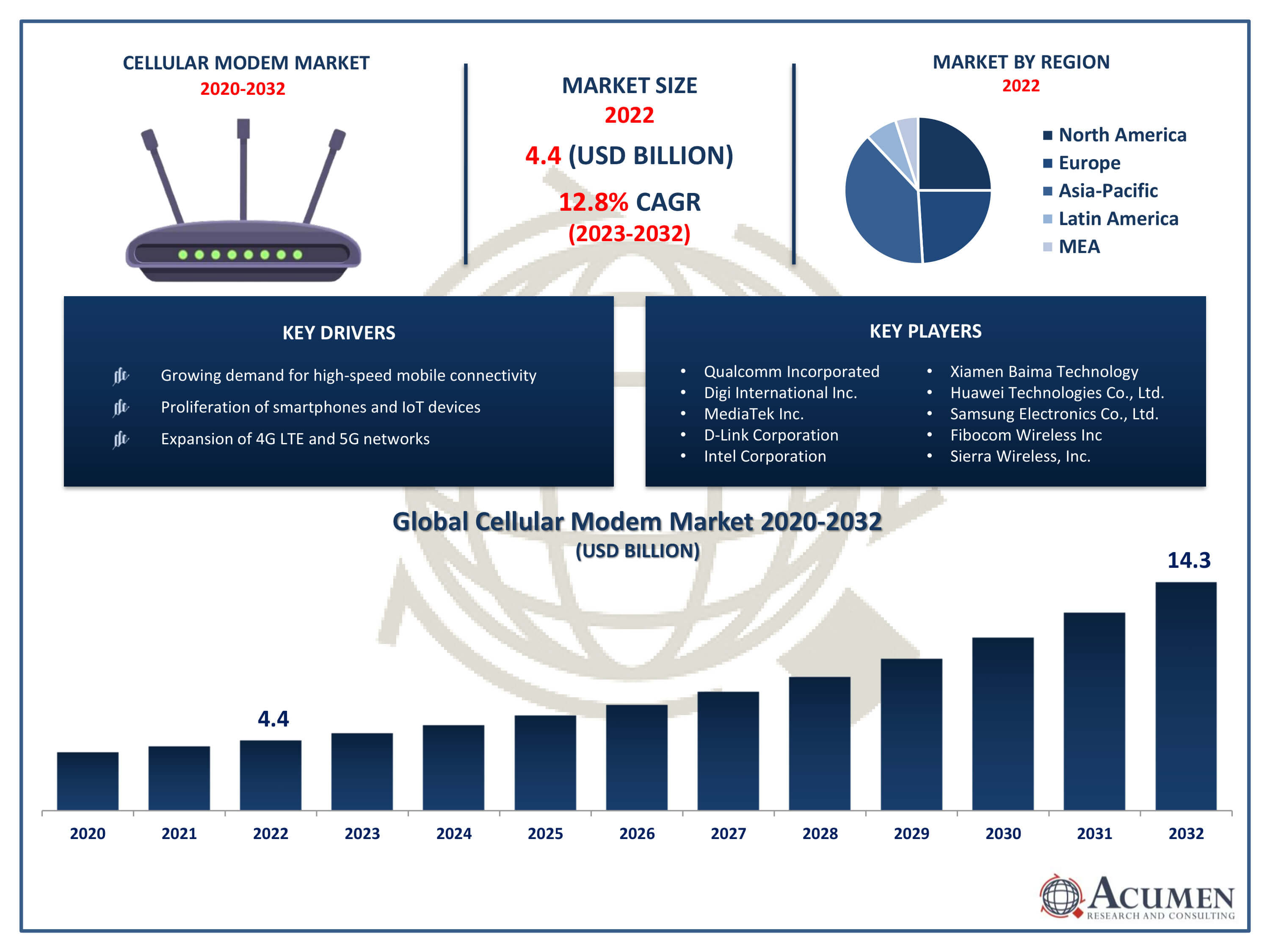Cellular Modem Market Size - Global Industry, Share, Analysis, Trends and Forecast 2023 - 2032
Published :
Report ID:
Pages :
Format :
Cellular Modem Market Size - Global Industry, Share, Analysis, Trends and Forecast 2023 - 2032
Report Coverage
- Industry Dynamics
- Market Size and Forecast Data
- Segment Analysis
- Competitive Landscape
- Regional Analysis with a Niche Focus on Country-Level Data
- High Level Analysis - Porter's, PESTEL, Value Chain, etc.
- Company Profiles of Key Players
- Option to Customize the Report As Per Your Specific Need
Request Sample Report
The Cellular Modem Market Size accounted for USD 4.4 Billion in 2022 and is projected to achieve a market size of USD 14.3 Billion by 2032 growing at a CAGR of 12.8% from 2023 to 2032.
Cellular Modem Market Highlights
- Global Cellular Modem Market revenue is expected to increase by USD 14.3 Billion by 2032, with a 12.8% CAGR from 2023 to 2032
- Asia-Pacific region led with more than 35% of Cellular Modem Market share in 2022
- Asia-Pacific Cellular Modem Market growth will record a CAGR of around 13.3% from 2023 to 2032
- By type, the embedded modems segment is the largest segment in the market, accounting for over 44% of the market share in 2022
- By application, the smartphones segment has recorded more than 19% of the revenue share in 2022
- Rising smartphone usage combined with an increase in remote work, drives the Cellular Modem Market value

A cellular modem is a device that enables communication between computing devices and the cellular network, allowing them to access the internet, send and receive data, and make voice calls. These modems are commonly used in smartphones, tablets, laptops, and other devices to establish a connection to the internet via cellular networks such as 4G LTE and 5G. Cellular modems play a crucial role in providing mobile connectivity and have become integral components in the rapidly evolving landscape of wireless communication.
The market for cellular modems has experienced significant growth in recent years, driven by the increasing demand for high-speed and reliable mobile connectivity. The proliferation of smartphones, the expansion of 4G LTE networks, and the ongoing rollout of 5G technology have fueled the adoption of cellular modems across various industries. The growing Internet of Things (IoT) ecosystem, where devices require seamless and efficient communication, further contributes to the expanding market. As technology continues to advance and the need for faster and more reliable connectivity persists, the cellular modem market is expected to continue its growth trajectory, with ongoing developments in 5G technology likely playing a pivotal role in shaping the market's future.
Global Cellular Modem Market Trends
Market Drivers
- Growing demand for high-speed mobile connectivity
- Proliferation of smartphones and IoT devices
- Expansion of 4G LTE and 5G networks
- Rising demand for telehealth and connected healthcare devices
Market Restraints
- Infrastructure challenges in certain regions
- Security and privacy concerns
Market Opportunities
- Ongoing advancements in 5G infrastructure
- Increasing applications in automotive and smart cities
Cellular Modem Market Report Coverage
| Market | Cellular Modem Market |
| Cellular Modem Market Size 2022 | USD 4.4 Billion |
| Cellular Modem Market Forecast 2032 | USD 14.3 Billion |
| Cellular Modem Market CAGR During 2023 - 2032 | 12.8% |
| Cellular Modem Market Analysis Period | 2020 - 2032 |
| Cellular Modem Market Base Year |
2022 |
| Cellular Modem Market Forecast Data | 2023 - 2032 |
| Segments Covered | By Type, By Technology, By Application, By Vertical, And By Geography |
| Regional Scope | North America, Europe, Asia Pacific, Latin America, and Middle East & Africa |
| Key Companies Profiled | Qualcomm Incorporated, Digi International Inc., MediaTek Inc., D-Link Corporation, Intel Corporation, Xiamen Baima Technology Co., Ltd., Huawei Technologies Co., Ltd., Samsung Electronics Co., Ltd., Fibocom Wireless Inc., and Sierra Wireless, Inc. |
| Report Coverage |
Market Trends, Drivers, Restraints, Competitive Analysis, Player Profiling, Covid-19 Analysis, Regulation Analysis |
A cellular modem serves as the interface between the device and the mobile network, enabling users to browse the internet, make voice calls, and transmit data wirelessly. Cellular modems utilize various cellular technologies, including 4G LTE and 5G, to provide high-speed, reliable, and ubiquitous connectivity. The applications of cellular modems are diverse and widespread. In the consumer electronics sector, they are prominently used in smartphones and tablets to enable mobile internet access and communication. Moreover, in the realm of IoT, cellular modems play a pivotal role in connecting a myriad of devices, ranging from smart home appliances and wearables to industrial sensors and healthcare devices. The automotive industry also extensively employs cellular modems for applications such as vehicle tracking, telematics, and in-car connectivity.
The cellular modem market has witnessed robust growth in recent years, driven by the ever-increasing demand for seamless and high-speed mobile connectivity. With the proliferation of smartphones, tablets, and a wide range of Internet of Things (IoT) devices, the need for reliable cellular modems has become paramount. The transition from 4G LTE to 5G technology has been a significant catalyst for market expansion, as it promises even faster data speeds, lower latency, and enhanced connectivity, opening up new possibilities for applications ranging from augmented reality to connected vehicles. Furthermore, the global push towards digital transformation and the rise of smart cities have fueled the adoption of cellular modems in various sectors. From healthcare and logistics to manufacturing and agriculture, industries are integrating cellular connectivity to enable real-time data exchange and enhance operational efficiency. The market's growth is also influenced by the ongoing development of innovative use cases, such as smart grids, remote monitoring, and intelligent transportation systems.
Cellular Modem Market Segmentation
The global Cellular Modem Market segmentation is based on type, technology, application, vertical, and geography.
Cellular Modem Market By Type
- Embedded Modems
- Wireless Hotspot/Routers
- USB Modems/Dongles
- Peripheral Component Interconnect Express (PCIe) Modems
According to the cellular modem industry analysis, the embedded modems segment accounted for the largest market share in 2022. Embedded modems, which are directly incorporated into the hardware of devices like laptops, tablets, and IoT gadgets, eliminate the need for external modem devices and provide a streamlined and compact solution for seamless connectivity. The demand for smaller, more power-efficient, and cost-effective communication solutions has propelled the adoption of embedded modems across diverse industries. One key factor contributing to the growth of embedded modems is the rapid expansion of the Internet of Things (IoT). As IoT devices continue to proliferate in various sectors such as healthcare, agriculture, and smart cities, the need for embedded modems has surged. These modems enable real-time data communication and remote monitoring, facilitating the efficient functioning of IoT ecosystems.
Cellular Modem Market By Technology
- 2G (Second Generation)
- 3G (Third Generation)
- 4G LTE (Fourth Generation Long-Term Evolution)
- 5G (Fifth Generation)
- NB-IoT
In terms of technologys, the 4G LTE segment is expected to witness significant growth in the coming years. As consumers and businesses increasingly demand faster data speeds and low-latency connectivity, the deployment of 4G LTE networks has expanded globally. The ubiquity of smartphones, tablets, and other connected devices has been a key driver for the growth of the 4G LTE cellular modem segment, as these devices leverage the technology to provide users with enhanced internet experiences. The growth of the 4G LTE segment is particularly pronounced in emerging markets, where the transition from 3G to 4G has unlocked new opportunities for digital access and connectivity. Additionally, industries such as healthcare, finance, and education have integrated 4G LTE-enabled devices and applications to enhance service delivery and improve operational efficiency.
Cellular Modem Market By Application
- Smartphones
- Smart Devices
- Wearables
- Tablets & Laptops
- IoT Devices
- Others
According to the cellular modem market forecast, the smartphone segment is expected to witness significant growth in the coming years. Smartphones, with their multifunctional capabilities and constant evolution, rely heavily on cellular modems to enable high-speed internet access, voice calls, and a myriad of data-intensive applications. The ever-growing adoption of smartphones across diverse demographics has significantly contributed to the expansion of the cellular modem industry. Advancements in smartphone technology, such as the integration of 4G LTE and the transition to 5G, have played a crucial role in shaping the growth of the smartphones segment. The demand for faster data speeds, lower latency, and improved network reliability has driven manufacturers to incorporate advanced cellular modems into their devices. The advent of 5G-enabled smartphones has further heightened the competition in the market, with users seeking cutting-edge connectivity experiences.
Cellular Modem Market By Vertical
- Agriculture
- Building Automation
- Automotive & Transportation
- Consumer Electronics
- Healthcare
- Energy & Utilities
- Industrial & Manufacturing
- Telecommunications
- Retail
- Others
Based on the vertical, the consumer electronics segment is expected to continue its growth trajectory in the coming years. This growth is driven by the increasing integration of connectivity features in a wide range of devices beyond smartphones. Products such as laptops, tablets, smartwatches, and smart home devices now often come equipped with cellular modems to provide users with seamless internet access on the go. This integration allows consumers to stay connected without relying solely on Wi-Fi networks, contributing to the growing demand for cellular modems in the consumer electronics sector. The rise of remote work, online education, and the increasing importance of staying connected in various aspects of daily life have further fueled the demand for cellular modems in consumer electronics. Laptops and tablets, in particular, have become essential tools for work and study, driving manufacturers to incorporate reliable and high-performance cellular modems.
Cellular Modem Market Regional Outlook
North America
- U.S.
- Canada
Europe
- U.K.
- Germany
- France
- Spain
- Rest of Europe
Asia-Pacific
- India
- Japan
- China
- Australia
- South Korea
- Rest of Asia-Pacific
Latin America
- Brazil
- Mexico
- Rest of Latin America
The Middle East & Africa
- South Africa
- GCC Countries
- Rest of the Middle East & Africa (ME&A)

Cellular Modem Market Regional Analysis
The Asia-Pacific region has emerged as a dominant force in the cellular modem market, driven by a combination of factors that underscore the region's rapid technological advancement, large population, and robust economic growth. One of the primary drivers is the sheer scale of mobile device adoption across countries in the region. With a significant portion of the global population, Asia-Pacific boasts a massive consumer base that actively embraces smartphones, tablets, and a wide array of IoT devices, all of which heavily rely on cellular modems for connectivity. Moreover, the relentless expansion of 4G LTE and the early adoption of 5G technology in several Asia-Pacific countries have further propelled the region's dominance in the cellular modem industry. Nations such as China, South Korea, and Japan have been at the forefront of 5G deployment, fostering an environment conducive to the growth of cellular technologies. The strategic investments in telecommunications infrastructure, government initiatives, and a tech-savvy population have collectively contributed to the region's leadership in driving innovation and setting trends within the global cellular modem market.
Cellular Modem Market Player
Some of the top cellular modem market companies offered in the professional report include Qualcomm Incorporated, Digi International Inc., MediaTek Inc., D-Link Corporation, Intel Corporation, Xiamen Baima Technology Co., Ltd., Huawei Technologies Co., Ltd., Samsung Electronics Co., Ltd., Fibocom Wireless Inc, and Sierra Wireless, Inc.
Frequently Asked Questions
How big is the cellular modem market?
The cellular modem market size was USD 4.4 Billion in 2022.
What is the CAGR of the global cellular modem market from 2023 to 2032?
The CAGR of cellular modem is 22.8% during the analysis period of 2023 to 2032.
Which are the key players in the cellular modem market?
The key players operating in the global market are including Qualcomm Incorporated, Digi International Inc., MediaTek Inc., D-Link Corporation, Intel Corporation, Xiamen Baima Technology Co., Ltd., Huawei Technologies Co., Ltd., Samsung Electronics Co., Ltd., Fibocom Wireless Inc, and Sierra Wireless, Inc.
Which region dominated the global cellular modem market share?
Asia-Pacific held the dominating position in cellular modem industry during the analysis period of 2023 to 2032.
Which region registered fastest CAGR from 2023 to 2032?
Asia-Pacific region exhibited fastest growing CAGR for market of cellular modem during the analysis period of 2023 to 2032.
What are the current trends and dynamics in the global cellular modem industry?
The current trends and dynamics in the cellular modem industry include growing demand for high-speed mobile connectivity, proliferation of smartphones and IoT devices, and expansion of 4G LTE and 5G networks.
Which technology held the maximum share in 2022?
The 4G LTE technology held the maximum share of the cellular modem industry.


